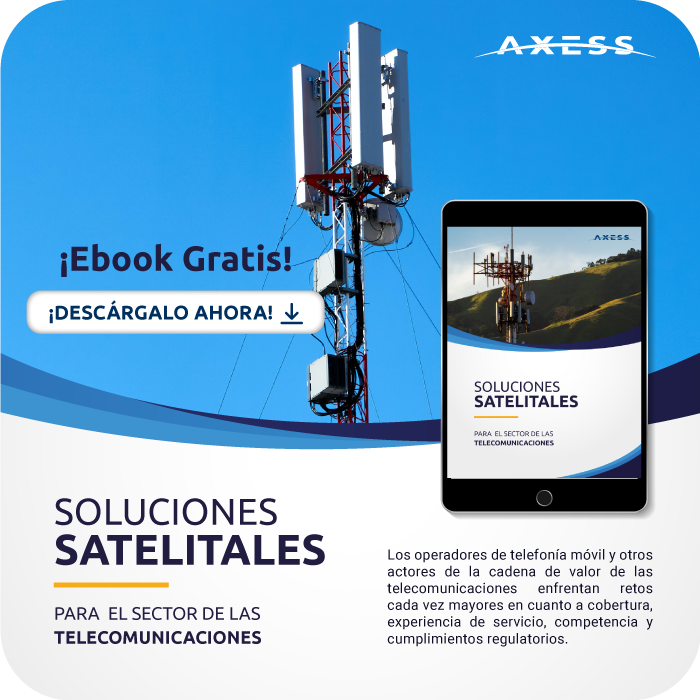
Axesat and CETel merge and AXESS Networks is born, the new global satellite leader
3 January, 2020
AXESS: first Latin American company to be listed in the three satellite operator rankings according to the WTA
3 February, 2020Satellite frequency Band C: an ally without limits
Band C why should you choose it for your business satellite link?
Telecommunications worldwide have evolved over time, giving people new ways to get in touch to generate business, build relationships between governments or broadcast mass events.
Within satellite communications, we find an important solution as usual, as surprising. These are the frequencies that operate under the C Band, in charge of, amongst others, the link transmissions of developed countries.
AXESS, presents all the advantages that you can find under the C Band, so that it becomes your ideal ally, understanding how and what it works for, making your business transcend borders:
C Band: a constant evolution
This frequency spectrum exists since the 60s, as it was the first frequency band that was assigned in the history of commercial satellite communications, used at the time for terrestrial microwave transmissions with line of view. Sometime later, the C band was applied to satellite communications, sharing the spectrum with fixed-service satellite stations (“FSS”) without a high risk of interference.
During the last 50 years, the C band has played a leading role for a wide range of communications in the commercial and government sectors, taking into account non-less important data, such as that practically every television that is turned on worldwide (including those used by the Armed Forces of the United States), receives a program which signal passes at some point through the satellite C Band. Also, in North America, military forces use this frequency to control radars, reach communications on the field and in command and control systems.
This is how the C Band works, nowadays
Commercial satellites operating in the C band, always use the band that comprises frequencies ranging from 3400 to 4200 MHz, when their mission is to transmit from the satellite to ground stations (Downlink). On the other hand, if the idea is to share transmission from the ground stations to the satellite, the band is extended from 5925 to 6725 MHz (Uplink).
To give a more specific explanation, we must point out that basically the satellite acts as a repeater; that is, it receives signals in the upper part of the band and immediately sends them to the Earth that receives it in the low band.
Understanding that the diameter of an antenna must be proportional to the wavelength it receives, the C Band requires antennas larger in size than those of the Ku Band, for example. Compared to the Ku Band, the C Band works more reliably under adverse weather conditions, such as heavy rain and hail, although they are likely to receive ground interference.
Amongst all the critical services it can offer, it also highlights actions that make the world go around as we know it today, that need greater reliability and a wide geographical coverage that only the C band can offer as they are, for example, banking transactions or business networks; distribution of television programs; mobile satellite service connection links, and emergency links, including disaster recovery services and weather monitoring.
The C band and its wide worldwide coverage
The waves that run through the C Band, cover large geographical areas and facilitate worldwide communications. Thanks to its large geographical reach, the beams that travel on the C band allow coverage to access remote places, which is mostly profitable in regions with low population density.
This band is also very much wanted, because the high level of fading caused by the rain which affects the signals of the Ku or Ka bands, makes the different operators to definitely transfer their operations to take advantage of the C Band, since it uses smaller centered beams that, in turn, are located in areas where the demand and population density are high, maintaining in all ways the quality of service required.
Although this is not an ideal frequency for mobile services, operators who apply these technologies see it as potentially attractive using it as an additional bandwidth source to serve their current and future customers, increasing coverage areas, download response speed for their users and expanding the frequencies in which their services operate. To round off, we must understand that the C Band is an ally of satellite communications, since its characteristics lend themselves, to reach every corner of the planet, without major investments in equipment. Also, it is fair to note that this technology is designed to overcome any meteorological difficulties, which allows your operation to develop normally, regardless of any extreme conditions. Keep in mind that the use of this band has regulations, so it is important to contact experts to get the best performance from this Band that connects the world.






